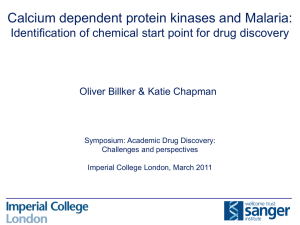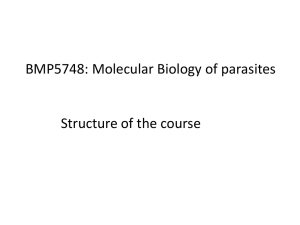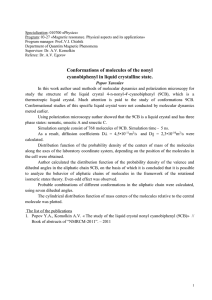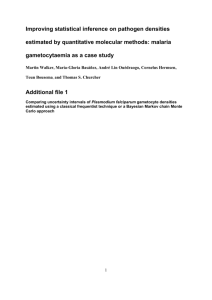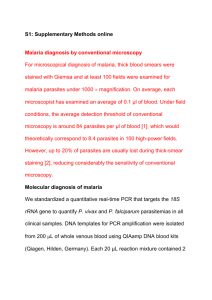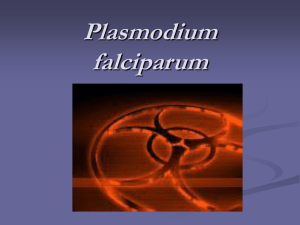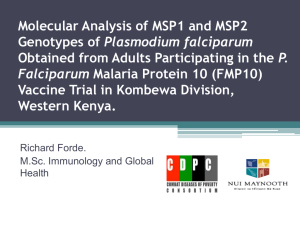Plasmepsin inhibitors: design, synthesis, inhibitory studies and crystal structure analysis
advertisement
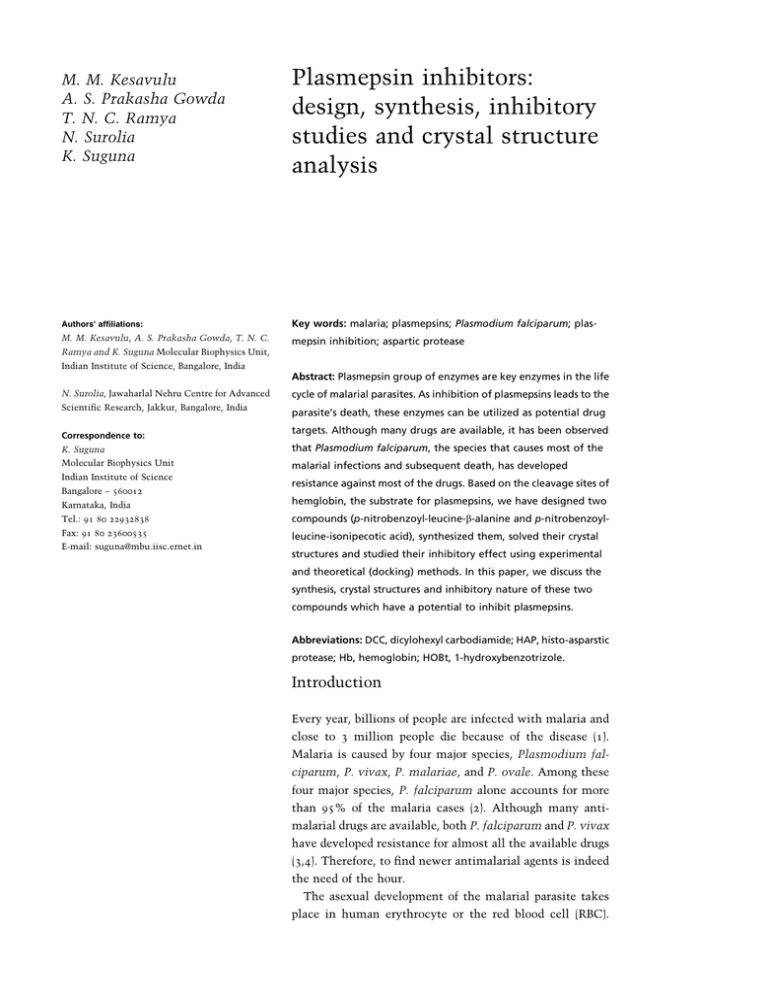
M. M. Kesavulu A. S. Prakasha Gowda T. N. C. Ramya N. Surolia K. Suguna Plasmepsin inhibitors: design, synthesis, inhibitory studies and crystal structure analysis Authors' affiliations: Key words: malaria; plasmepsins; Plasmodium falciparum; plas- M. M. Kesavulu, A. S. Prakasha Gowda, T. N. C. mepsin inhibition; aspartic protease Ramya and K. Suguna Molecular Biophysics Unit, Indian Institute of Science, Bangalore, India Abstract: Plasmepsin group of enzymes are key enzymes in the life N. Surolia, Jawaharlal Nehru Centre for Advanced Scientific Research, Jakkur, Bangalore, India Correspondence to: cycle of malarial parasites. As inhibition of plasmepsins leads to the parasite’s death, these enzymes can be utilized as potential drug targets. Although many drugs are available, it has been observed K. Suguna that Plasmodium falciparum, the species that causes most of the Molecular Biophysics Unit malarial infections and subsequent death, has developed Indian Institute of Science Bangalore – 560012 resistance against most of the drugs. Based on the cleavage sites of Karnataka, India hemglobin, the substrate for plasmepsins, we have designed two Tel.: 91 80 22932838 compounds (p-nitrobenzoyl-leucine-b-alanine and p-nitrobenzoyl- Fax: 91 80 23600535 leucine-isonipecotic acid), synthesized them, solved their crystal E-mail: suguna@mbu.iisc.ernet.in structures and studied their inhibitory effect using experimental and theoretical (docking) methods. In this paper, we discuss the synthesis, crystal structures and inhibitory nature of these two compounds which have a potential to inhibit plasmepsins. Abbreviations: DCC, dicylohexyl carbodiamide; HAP, histo-asparstic protease; Hb, hemoglobin; HOBt, 1-hydroxybenzotrizole. Introduction Every year, billions of people are infected with malaria and close to 3 million people die because of the disease (1). Malaria is caused by four major species, Plasmodium falciparum, P. vivax, P. malariae, and P. ovale. Among these four major species, P. falciparum alone accounts for more than 95% of the malaria cases (2). Although many antimalarial drugs are available, both P. falciparum and P. vivax have developed resistance for almost all the available drugs (3,4). Therefore, to find newer antimalarial agents is indeed the need of the hour. The asexual development of the malarial parasite takes place in human erythrocyte or the red blood cell (RBC). During this stage, the parasite utilizes hemoglobin (Hb) of RBC as the only source of food. Three different classes of enzymes present in the food vacuole of the malarial parasite – falcipain (cysteine protease) (5), falcilysin (metalloprotease) (6) and plasmepsins (aspartic proteases) (7) – are responsible for the digestion of Hb. Of the three different classes of enzymes involved in the digestion of Hb, plasmepsins are known to be the key enzymes as they initiate the catalytic breakdown of Hb. Hence, these enzymes can be probed as potential drug targets. Three aspartic proteases (plasmepsin I, II and IV) and one histoaspartic protease (HAP) are involved in Hb degradation (8,9). Plasmepsins I and II are involved in the first phase of Hb degradation, while plasmepsin IV and HAP either partially digest Hb or act on the degradation products of the first phase to cleave them into smaller peptides. Recent genome data of P. falciparum revealed the presence of six more plasmepsins (plasmepsins V to X) in the parasite. These enzymes share much less similarity among themselves and with the other four aspartic proteases and their functions are not yet known. Since the identification of plasmepsins in 1994 (10), numerous attempts have been made to design inhibitors of plasmepsins with a view to develop them into potent anti- Figure 1. Chemical structures of (A) p-nitrobenzoyl-leucine-b-alanine (Asp-12) and (B) p-nitrobenzoyl-leucine-isonipecotic acid (Asp-20). malarial drugs. A wide variety of them have been designed, synthesized, checked for activity by enzyme assays as well synthesized two small compounds (Fig. 1) based on the Hb as in parasite cultures. They include both peptide-like cleavage sites of plasmepsins and also incorporated a b- (7,11,12) and non-peptidyl (4,13,14) inhibitors. Some of them amino acid in one of them and the isonipecotic acid group in were designed based on the substrate structure (Phe33- the other as alternate strategies for inhibitor design with a Leu34 of Hb) (15) and/or statine residue (16) of the universal view to test the feasibility of developing them as effective aspartic protease inhibitor, pepstatin. C2 symmetric (17) and antimalarials. To study the interaction of these compounds achiral inhibitors (4) were also reported. The determination with plasmepsin I, we have crystallized both the com- of the crystal structure of plasmepsin II in complex with pounds, determined their crystal structures and performed pepstatin revealed intricate details of the mode of binding docking studies using the crystal structures, the results of and provided a platform for the structure-based design (18). which are presented in this paper. Subsequent crystal structures of plasmemsin II with other inhibitors (13,15) revealed the conformational flexibility of the binding pocket and an entirely new type of binding (19). Experimental Procedures Modeling/docking, molecular dynamics and interaction energy calculations were also performed in many studies Synthesis of compounds (4,17). Some of the compounds could successfully inhibit the enzyme but failed to stop the parasite growth in cell The compounds were synthesized by the stepwise solution- culture (4,7,18) probably because of their size that prevents phase method. Dicyclo hexylcarbodiamide (DCC) was used the access to the food vacuole of the parasite where the Hb for the formation of the peptide bond. degradation occurs. The strategy for a viable drug is to find a relatively small, cost-effective and highly specific inhibitor. p-(NO2)-Ba-(L),(D)-Leu-b-Ala-OMe (Asp-12 & Asp-13) Although many inhibitors targeting the plasmepsin group of p-(NO2)-Ba-(l)-Leu-OH or p-(NO2)-Ba-(d)-Leu-OH (0.9 g, enzymes are available, none of them are in use as drugs for 3.21 mm) was dissolved in 10 mL of ethyl acetate and the treatment of malaria today. We have designed and cooled to 0 C in an ice bath. H-b-Ala-OMe, isolated from Table 1. Details of crystal data, data collection and refinement parameters Asp-12/Asp-13 Asp-20/Asp-21 Empirical formula C17H23N3O6 C20H27N3O6 Crystal size (mm) 0.44 · 0.19 · 0.09 0.2 · 0.17 · 0.1 Crystallizing solvent Acetone Acetone Crystal system Triclinic Monoclinic Space group P1 C 1 2/c 1 Unit cell dimensions a (Å) 8.791(3) 17.246(4) b (Å) 9.725(3) 12.800(3) c (Å) 11.165(4) 19.708(4) a () 92.231(6) 90 b () 95.723(6) 96.138(5) c () 98.977(6) 90 Volume (Å3) 936.7(13) 4325.36(29) Z 2 8 Mr 365.4 405.5 Density (g/cm3) (cal) 1.3 1.25 F(000) 387.9 1727.7 Radiation (k in Å) MoKa (0.71073) MoKa (0.71073) Temperature (C) 20 25 Unique reflections 3913 2278 p-(NO2)-Ba-(L),(D)-Leu-Ina-OMe (Asp-20 & Asp-21) Observed reflections 3023 1374 p-(NO2)-Ba-(l)-Leu-OH or p-(NO2)-Ba-(d)-Leu-OH (0.28 g, Final R (%) 3.63 6.76 1.0 mm) was dissolved in 5 mL of ethyl acetate and cooled to 0 C in an ice bath. H-Ina-OMe (Ina-isonipecotic acid), iso- Figure 2. Molecular conformation of (A) Asp-12 & Asp-13 and (B) Asp-20. The thermal ellipsoids are at 50% probability level. Final wR2 (%) 7.56 14.62 Goodness of fit (S) 0.957 1.009 lated from 0.28 g (2.0 mm, 2 eq.) of hydrochloride was Dqmax (e Å ) 0.120 0.428 neutralized, followed by extraction with ethyl acetate, and Dqmin (e Å)3) )0.093 )0.154 concentration to approximately 5 mL. It was then added to p- Data-to-param ratio 8.2:1 8.5:1 (NO2)-Ba-Leu-OH under stirring while maintaining the )3 temperature at 0 C, followed immediately by the addition of DCC/HOBt of 0.21 g (1.0 mm)/0.14 g (1.0 mm). The reaction 0.7 g (6.42 mm, 2 eq.) of hydrochloride was neutralized, mixture was allowed to reach room temperature and stirred followed by extraction with ethyl acetate and concentration for 3–4 h. The precipitated dicyclohexylurea was filtered off. to approximately 5 mL. It was then added to p-(NO2)-Ba- The organic layer was washed successively with 2 n HCl Leu-OH under stirring while maintaining the temperature (3 · 50 mL), brine (3 · 50 mL), 1 m sodium carbonate at 0 C, followed immediately by the addition of DCC/1- (3 · 50 mL) and brine (3 · 50 mL). This layer was then dried hydroxybenzotrizole (HOBt) of 0.70 g (3.21 mm)/0.43 g over anhydrous sodium sulfate and was evaporated to yield a (3.21 mm). The reaction mixture was allowed to reach room white solid. The crude peptide was recrystalized from pet- temperature and stirred for 3–4 h. The precipitated dic- roleum ether to obtain Asp-20/Asp-21. The sample was yclohexylurea was filtered off. The organic layer was wa- purified over silica gel using chloroform–methanol as an shed successively with 2 n HCl (3 · 50 mL), brine elutant to yield 0.35 g (0.86 mm, 86.30%) of Asp-20/Asp-21. (3 · 50 mL), 1 m sodium carbonate (3 · 50 mL) and brine (3 · 50 mL). This layer was then dried over anhydrous sodium sulfate and was evaporated to yield a white solid. The Characterization crude peptide was recrystallized from petroleum ether to obtain Asp-12/Asp-13. The sample was purified over silica Elemental analysis of the compounds was carried out using gel using chloroform–methanol as an elutant to yield 0.96 g a ThermoFinnigan FLASH EA 1112 CHNS analyser (Ther- (2.63 mm, 82.10%) of Asp-12/Asp-13. mo Electron Corporation, Waltham, MA, USA) and the Table 2. Coordinates and equivalent isotropic thermal parameters (· 103 Å2) of nonhydrogen atoms (estimated standard deviations are given in parentheses) Asp-12 O1 )0.5067 (0.0070) )1.4406 (0.0067) 1.5154 (0.0061) 1060 (30) O2 0.1822 (0.0071) 0.0081 (0.0063) 0.0504 (0.0058) 1189 (29) N1 0.0890 (0.0071) )0.4805 (0.0076) 1.1807 (0.0074) 886 (31) C1 0.7506 (0.0075) 0.2754 (0.0072) 2.3204 (0.0075) 578 (30) C2 0.6096 (0.0077) )0.1022 (0.0055) 3.5786 (0.0069) 702 (30) C3 1.2293 (0.0071) 0.6880 (0.0068) 4.6132 (0.0063) 585 (27) C4 1.9832 (0.0064) 1.7183 (0.0061) 4.2803 (0.0064) 480 (23) C5 2.1786 (0.0071) 2.0284 (0.0083) 2.9870 (0.0075) 804 (32) C6 1.5215 (0.0087) 1.2953 (0.0098) 1.9448 (0.0075) 922 (40) C7 2.7881 (0.0062) 2.4696 (0.0067) 5.3023 (0.0064) 578 (31) O3 3.5516 (0.0059) 3.3398 (0.0056) 4.9106 (0.0056) 957 (23) N2 2.6303 (0.0055) 2.2322 (0.0053) 6.5935 (0.0048) 572 (23) C8 3.4035 (0.0064) 2.9187 (0.0063) 7.6185 (0.0064) 627 (27) C9 2.6750 (0.0068) 3.0248 (0.0085) 8.8924 (0.0074) 797 (33) C10 3.4081 (0.0069) 3.7288 (0.0064) 10.0557 (0.0058) 600 (26) C11 2.5807 (0.0102) 3.5924 (0.0098) 11.3526 (0.0083) 1007 (39) C12 3.7013 (0.0093) 5.2028 (0.0074) 9.8164 (0.0087) 1000 (40) C13 4.7541 (0.0059) 2.2119 (0.0063) 7.7960 (0.0054) 373 (23) O4 4.8284 (0.0040) 1.0535 (0.0044) 8.1494 (0.0040) 541 (18) N3 5.8411 (0.0047) 2.9984 (0.0050) 7.5924 (0.0049) 467 (20) C14 7.2394 (0.0058) 2.4862 (0.0066) 7.7391 (0.0063) 533 (22) C15 7.5627 (0.0063) 2.4046 (0.0059) 9.2402 (0.0063) 452 (25) C16 7.5353 (0.0068) 3.7258 (0.0072) 9.9451 (0.0073) 561 (30) O5 7.6104 (0.0057) 4.7796 (0.0050) 9.3857 (0.0053) 795 (23) O6 7.4462 (0.0053) 3.6019 (0.0047) 11.2404 (0.0050) 744 (21) C17 7.4488 (0.0113) 4.8222 (0.0094) 12.0421 (0.0094) 1386 (52) O7 5.6127 (0.0067) 1.1787 (0.0074) 15.8850 (0.0064) 1248 (31) O8 6.3195 (0.0065) 2.5602 (0.0061) 14.4591 (0.0063) 1104 (28) N4 5.6861 (0.0069) 1.5165 (0.0075) 14.7451 (0.0060) 731 (30) C18 5.0287 (0.0072) 0.7412 (0.0073) 13.7249 (0.0068) 567 (29) C19 5.1982 (0.0064) 1.1325 (0.0070) 12.4067 (0.0068) 730 (31) C20 4.5564 (0.0080) 0.4735 (0.0071) 11.4689 (0.0071) 725 (32) C21 3.7138 (0.0066) )0.6545 (0.0070) 11.7126 (0.0068) 570 (29) C22 3.6911 (0.0096) )1.0572 (0.0095) 13.0638 (0.0083) 1028 (39) C23 4.2925 (0.0099) )0.3978 (0.0094) 14.0296 (0.0089) 946 (37) C24 2.9622 (0.0077) )1.4539 (0.0061) 10.7227 (0.0070) 647 (32) O9 2.1712 (0.0060) )2.3257 (0.0063) 11.0692 (0.0051) 1044 (27) N5 3.1430 (0.0049) )1.1632 (0.0046) 9.4130 (0.0053) 501 (21) C25 2.3376 (0.0059) )1.8784 (0.0053) 8.4144 (0.0053) 430 (22) C26 3.1129 (0.0063) )1.9559 (0.0059) 7.0886 (0.0063) 507 (25) C27 2.3997 (0.0069) )2.6978 (0.0066) 5.9524 (0.0073) 627 (31) C28 3.2062 (0.0097) )2.5632 (0.0092) 4.6998 (0.0083) 991 (35) C29 2.1428 (0.0086) )4.1365 (0.0071) 6.2802 (0.0072) 849 (32) C30 1.0169 (0.0071) )1.1951 (0.0068) 8.2192 (0.0060) 500 (27) O10 0.9483 (0.0040) 0.0211 (0.0040) 7.8431 (0.0042) 549 (18) Asp-13 Table 2. Continued N6 )0.0526 (0.0054) )1.8982 (0.0047) 8.4361 (0.0050) 476 (21) C31 )1.3601 (0.0065) )1.4275 (0.0055) 8.2055 (0.0061) 463 (23) C32 )1.7958 (0.0074) )1.3366 (0.0066) 6.7547 (0.0066) 569 (29) C33 )1.7847 (0.0060) )2.6770 (0.0070) 6.0996 (0.0067) 493 (26) O11 )1.8240 (0.0056) )3.7593 (0.0049) 6.6511 (0.0053) 770 (24) O12 )1.7382 (0.0051) )2.5364 (0.0046) 4.7605 (0.0049) 725 (22) C34 )1.7024 (0.0078) )3.7538 (0.0074) 3.9848 (0.0071) 749 (32) Asp-20 O4 )0.7270 (0.0031) 0.1389 (0.0038) 11.8792 (0.0031) 559 (14) O3 )3.1508 (0.0031) )2.2724 (0.0035) 11.8319 (0.0035) 580 (14) N2 )1.8218 (0.0043) )1.7139 (0.0042) 10.1143 (0.0049) 494 (17) N3 )0.1124 (0.0040) )1.5201 (0.0045) 13.2575 (0.0043) 555 (17) C4 )4.2251 (0.0050) )1.5985 (0.0045) 9.8276 (0.0055) 462 (20) C1 )6.5243 (0.0057) )1.2527 (0.0049) 8.3882 (0.0069) 582 (25) O2 )8.8317 (0.0049) )1.0625 (0.0046) 8.2334 (0.0055) 1070 (23) C7 )3.0131 (0.0052) )1.8811 (0.0049) 10.6790 (0.0059) 482 (22) C9 0.6009 (0.0047) )1.8893 (0.0050) 10.0212 (0.0049) 556 (23) C8 )0.6291 (0.0045) )2.0125 (0.0049) 10.9002 (0.0047) 483 (22) C2 )5.3693 (0.0061) )1.4853 (0.0052) 7.7225 (0.0055) 621 (22) N1 )7.7766 (0.0063) )1.0992 (0.0054) 7.5989 (0.0073) 851 (29) C5 )5.4213 (0.0057) )1.3463 (0.0051) 10.4597 (0.0055) 621 (24) C13 )0.5101 (0.0045) )1.0645 (0.0061) 12.0655 (0.0053) 448 (21) C3 )4.2171 (0.0052) )1.6636 (0.0049) 8.4473 (0.0055) 578 (23) C6 )6.5868 (0.0056) )1.1759 (0.0054) 9.7523 (0.0067) 678 (26) C18 0.2201 (0.0054) )0.5858 (0.0056) 14.3283 (0.0051) 661 (24) C16 2.1215 (0.0050) )2.0873 (0.0063) 14.9781 (0.0053) 670 (25) C17 1.6925 (0.0056) )0.6754 (0.0064) 14.6389 (0.0053) 756 (27) 0.1960 (0.0054) )2.8947 (0.0058) 13.6053 (0.0055) 717 (26) O1 )7.6832 (0.0049) )1.0464 (0.0054) 6.4075 (0.0059) 1208 (22) O6 4.0867 (0.0051) )1.2391 (0.0070) 15.8755 (0.0067) 1573 (35) C11 0.8276 (0.0090) )4.1912 (0.0078) 9.0855 (0.0082) 1591 (49) C15 1.6636 (0.0056) )3.0613 (0.0058) 13.8919 (0.0055) 751 (27) O5 4.1745 (0.0057) )3.2673 (0.0083) 15.1141 (0.0067) 1756 (37) C10 0.6738 (0.0061) )2.7537 (0.0069) 8.7846 (0.0059) 810 (30) C19 3.5909 (0.0078) )2.2182 (0.0120) 15.2534 (0.0074) 1164 (46) 1.7923 (0.0080) )2.2473 (0.0091) 7.8728 (0.0073) 1517 (47) )1.3150 (0.0132) 16.1502 (0.0102) 2452 (79) C14 C12 C20 5.5308 (0.0075) composition was confirmed (Asp-12: C17H23N3O6 and performed by injecting the samples into a C18 reverse-phase Asp-20: C20 H27N3O6). Mass of the compounds was deter- column (4.6 · 150 mm, 5 lm) and eluting with acetonitrile. mined by electronspray mass spectrometry (Asp-12: Mcal ¼ Single peaks (retention time 4.62 min for Asp-12 and 365.4, Mobs ¼ 366.2; Asp-20: Mcal ¼ 405.5, Mobs ¼ 404.3). 3.49 min for Asp-20) were detected with absorbance detector The purity of the compounds was confirmed by thin-layer at 230 nm). The melting points were found to be between 118 chromatography (TLC) by spotting them on silica gel 60 and 119 C for both the compounds. plates and developing with the following solvent systems: (i) The 1H-nuclear magnetic resonance (NMR) spectra were chloroform:methanol:acetic acid 9:3:1 and (2) hexane:ethyl recorded in CDCl3 and the 13C-NMR spectra were recorded acetate 13:7. High-pressure liquid chromatography was in dimethyl sulfoxide (DMSO)-d6 with 400 MHz Bruker Table 3. Hydrogen bonds N…O distance (Å) —N–H…O () Symmetry Intramolecular (Asp-12/Asp-13) N2…O10 3.046 165.3 N5…O4 3.058 165.7 Intermolecular (Asp-12/Asp-13) N3…011 3.026 175.5 x+1 y+1 z N6…05 3.103 176.1 x)1 y)1 z 172.0 )x )y )z + 1 Intermolecular (Asp-20) N2…04 2.903 DRX instrument (Bruker Biospin Corporation, Billerica, MA, 3.67, 3.51 (2H CH2 leucyl side chain), d 2.53, 2.03 (2H CH2- USA) at 25 C. For Asp-12 1H-NMR: d 8.18 (2H aryl), d 7.92 CH2), d 1.87, 1.69 (4H CH2CH2), d 0.93 (6H terminal methyl (2H aryl), d 7.5 (1H amido),d 6.92 (1H amido), d 4.65 (1H CH), d of leucyl side chain); 13 C NMR: d 171.97 (amide), d 171.75 (carboxyl), d 164.81 (amide), d 149.12 (aryl), d 139.88 (aryl), d 129.08 (aryl), d 123.38 (aryl), d 52.14 (aliphatic), d 51.33 (aliphatic), d 40.47 (aliphatic), d 40.18 (aliphatic), d 39.98 (aliphatic), d 39.77 (aliphatic), d 39.56 (aliphatic), d 39.35 (aliphatic), d 38.95 (aliphatic), d 34.9(aliphatic), d 33.62(aliphatic), d 24.48 (aliphatic), d 22.96 (aliphatic), d 21.49 (aliphatic) and for Asp-20 1H-NMR: d 8.35 (2H aryl), d 8.19 (2H aryl), d 4.54 (1H CH leucyl residue), d 3.67 (3H CH3 terminal methyl), d 3.34 (2H piperidine), d 2.33 (1H piperidine), d 1.85 (2H piperidine), d 1.83 (1H CH of leucyl side chain), d 1.79 (1H CH2 of leucyl side chain), d 1.08 (6H CH3 terminal methyl of leucyl side chain); 13C-NMR: d 177.1 (amido), d 176 (carboxyl), d 168 (amido), d 152.1 (aryl), d 139.8 (aryl), d 128 (aryl), d 123.5 (aryl), d 51.5 (aliphatic), d 50.8 (aliphatic), d 43 (piperidine), d 41.5 (piperidine), d 37.8 (piperidine), d 24.8 (aliphatic), d 22.7 (aliphatic), d 21.3 (aliphatic). Assessment of inhibition of growth of P. falciparum cultures by peptides Experiments requiring Plasmodium cultures used chloroquine-sensitive P. falciparum strain FCK2 (CQ-sensitive; IC50 18 nm) parasites from Karnataka, India, cultivated in O+ human erythrocytes in medium supplemented with O+ human serum by the candle jar method of Trager and Jenson (20). Culture synchrony was maintained by 5% sorbitol treatment (21), and parasites were observed for viability and any changes in morphology by standard staining procedures (Giemsa staining). Growth inhibition by the peptides of interest was assessed by monitoring the uptake of [3H] hypoxanthine (22). Synchronized parasites in the early trophozoite stage were culFigure 3. Crystal packing in (A) Asp-12 & Asp-13 and (B) Asp-20. tured in 96-well plates (Nunc, Copenhagen, Denmark) in Relative percent parasitemia A 120 100 80 60 40 20 0 –2 0 2 4 6 4 6 Log (nM ASP12) Relative percent parasitemia B 120 100 80 60 40 20 0 –2 0 2 Log (nM ASP20) Figure 5. In vitro growth inhibition assay of the malaria parasite by the peptides (A) Asp-12 and (B) Asp-20. SigmaPlot 2000 software (Systat Software Inc., Point Richmond, CA, USA). This allowed the calculation of IC50. Crystallization and data collection details Figure 4. Results of molecular docking. (A) Asp-12 in the binding cleft of plasmepsin I. (B) Details of interactions between Asp-12 and plasmepsin I. As Asp-12 was as inhibitory as Asp-13 and Asp-20 and culture medium supplemented with 10% serum at 10% the equimolar mixtures of compounds (Asp-12/13 and hematocrit and at an initial parasitemia of at least 3%. Asp-20/21) were prepared in acetone as a solvent and the Different concentrations of the peptide in DMSO were ad- crystals were grown by slow evaporation of acetone at Asp-21 are likewise equally active, saturated solutions of ded such that the final concentration of DMSO did not room temperature. Crystals grew in 7 days of crystalliza- exceed 0.05%. Every peptide concentration was tested in tion setup. The X-ray data were collected on a Bruker AXS triplicate. [3H] hypoxanthine was added to the culture after SMART APEX CCD diffractometer, using MoKa radiation incubation with peptide for 48 h and the cultures were fur- (k ¼ 0.71073 Å). The structures were determined and re- ther incubated for 31 h. The cultures from the wells of the fined using SHELXS-97 and SHELXL-97 (23), respectively. plate were harvested using a Nunc cell harvester and inhibition of P. falciparum growth was assessed by measuring the incorporation of [3H] hypoxanthine using a liquid scin- Molecular modeling tillation counter (Wallac, Global Medical Instrumentation Inc, Ramsey, MN, USA). The relative percent parasitemia As the initial cleavage of Hb is likely to be carried out by was plotted vs. log concentration of the inhibitor and the plasmepsin I, the structure of plasmepsin I modeled based on curve was fit to non-linear regression analysis using the coordinates of plasmepsin II [PDB code:1SME (18)] using the program SYBYL (24) was used as a target for docking We could dock all of them in the binding cleft of plas- studies. The identity between the two plasmepsins (plas- mepsin I. They block the active site by directly interacting mepsins I and plasmepsin II) is 53.1%. The peptides Asp-12, with either one or both of the catalytic aspartates, Asp34 Asp-13 and Asp-20, Asp-21 were docked into the modeled and Asp214 and also with Ser79 situated at the tip of the plasmepsin I with the program Autodock 3 (25), using the flexible ÔflapÕ region. The interaction energies are in the crystal structure coordinates of the peptides. Autodock 3 range of )9 to )8 kcal/mol. The binding modes of one of creates a grid box around the protein, pre-calculates the en- them is shown in Fig. 4. ergy values at the grid points, randomly places ligand (inhibitors) and evaluates successive random changes in the position, orientation and conformational changes using a Inhibition of parasite growth simulated annealing coupled with the metropolis energy test. The inhibitory studies indicated no inhibition by Asp-12 & Asp-13 on P. falciparum cultures up to a concentration of Results 100 lM, while Asp-20 & Asp-21 inhibited the P. falciparum with an IC50 of 84 lm (Fig. 5). Crystal structures The details of crystal system and diffraction and refinement Discussion parameters of the two compounds are summarized in Table 1. The structures were determined by direct methods Degradation of Hb by enzymes present in the food and the hydrogen atoms were located in difference Fourier vacuole of the malarial parasite is the key step for maps. Anisotropic thermal parameters of the non-hydrogen parasite’s survival. Although three different classes of atoms were refined in the final cycles of the refinement. enzymes are involved in the Hb degradation process, Non-hydrogen atoms with their thermal ellipsoids are plasmepsins play a major role in the initial degradation of shown in Fig. 2. Hb. These enzymes can be utilized as targets for drug The coordinates of non-hydrogen atoms with their equiv- development and discovery. There are many peptide like alent isotropic thermal parameters are given in Table 2. compounds such as pepstatin and others, which inhibit Hydrogen bonds in the crystal structures are given in Table 3. plasmepsins effectively, but their inhibitory action is Asp-12 and Asp-13 crystallize in space group P1 with one limited only to plasmepsin enzymes and they do not molecule each in the asymmetric unit. Two hydrogen bonds show much effect on parasitic growth. This may be due exist between these two molecules, made by the nitrogen and to their longer chain size because of which they fail to the carbonyl carbon atoms of the leucine residue. In addition, gain entry into the parasite food vacuole, where Hb deg- the molecules are stabilized in the lattice by two additional radation takes place. intermolecular hydrogen bonds (Table 3, Fig. 3). Asp-20 and In our study we have used two compounds which are very Asp-21 crystallize in space group C2/c with one molecule in small in size and effectively bind in the active site. The the asymmetric unit. Thus in the crystal Asp-20 and Asp-21 determination of their crystal structures enabled more are related by the crystallographic symmetry. These two accurate and faster docking calculations. Although docking molecules are also held by intermolecular hydrogen bonds studies showed that all the four compounds bind reasonably made between the nitrogen and the carbonyl oxygen atoms of well at the active site with favourable energy, in contra- the leucine residue (Table 3, Fig. 3). diction to this, our experimental data showed only Asp-20/ Asp-21 cause inhibition of parasite growth. The contradictory result of docking and experimental studies is due to Docking studies the fact that docking is performed directly on the enzyme. Our experimental and computational results show that Molecular docking of these four compounds into modeled Asp-20/Asp-21 have a better potential to inhibit plasmep- plasmepsin I resulted in negative interaction energy with sins, whereas it is required to modify the design of Asp-12/ efficient binding. Hybrid search (global and adaptive local) Asp-13 to make them more effective as inhibitors of plas- of 50 cycles was carried out for all the four compounds. mepsins. Acknowledgements: X-ray diffraction data were collected using Technology of India. The work was funded by the Council of Sci- the CCD diffractometer facility at the Indian Institute of Science entific and Industrial Research. supported by the IRPHA program of the Department of Science & References 1. Breman, J.G., Alilio, M.S. & Mills, A. (2004) 9. Banerjee, R., Liu, J., Beatty, W., Klemba, M. 17. Ersmark, K., Feierberg, I., Bjelic, S., Conquering the intolerable burden of & Goldberg, D.E. (2002) Four plasmepsins Hamelink, E., Hackett, F., Blackman, M.J., malaria: what’s new, what’s needed: a are active in the Plasmodium falciparum Hulten, J., Samuelsson, B., Aqvist, J. & summary. Am. J. Trop. Med. Hyg. 71S, 1–15. food vacuole, including a protease with an Hallberg, A. (2004) Potent inhibitors of the 2. Oaks, S.C., Mitchell, V.S., Jr, Pearson, G.W. active site histidine. Proc. Natl. Acad. Sci. Plasmodium falciparum enzymes USA 99, 990–995. plasmepsins I and II devoid of cathepsin D & Carpenter, C.C.J., eds (1991) Malaria: Obstacles and Opportunities. A report of 10. Coombs, G.H., Goldberg, D.E., Klemba, M., inhibitory activity. J. Med. Chem. 47, the committee for the study on malaria Berry, C., Kay, J. & Mottram, J.C. (2001) prevention and control: Status review and Aspartic proteases of Plasmodium alternate strategies. Division of falciparum and other parasitic protozoa as P., Collins, J., Bhat, T.N., Collins, P.J., International Health, Institute of Medicine, drug targets. Trends Parasitol. 17, 532–537. Cachau, R.E., Luker, K.E., Gluzman, I.Y., National Academy, Washington, DC. 3. White, N.J. (1998) Drug resistance in malaria. Br. Med. Bull. 54, 703–715. 4. Jiang, S., Prigge, S.T., Wei, L., Gao, Y.E., 11. Noteberg, D., Hamelink, E., Hulten, J., 110–122. 18. Silva, A.M., Lee, A.Y., Gulnik, S.V., Majer, Francis, S.E., Oksman, A., Goldberg, D.E. & Wahlgren, M., Vrang, L., Samuelsson, B. & Erickson, J.W. (1996) Structure and Hallberg, A. (2003) Design and synthesis of inhibition of plasmepsin II, a hemoglobin plasmepsin I and plasmepsin II inhibitors degrading enzyme from Plasmodium Hudson, T.H, Gerena, L., Dame, J.B. & Kyle, with activity in Plasmodium falciparum- falciparum. Proc. Natl. Acad. Sci. USA. 93, D.E. (2001) New class of small nonpeptidyl infected cultured human erythrocytes. 10034–10039. compounds blocks Plasmodium falciparum development in vitro by inhibiting J. Med. Chem. 46, 734–746. 12. Johansson, P.-O., Lindberg, J., Blackman, 19. Prade, L., Jones, A.F., Boss, C., RichardBildstein, S., Meyer, S., Binkert, C. & Bur, D. plasmepsins. Antimicrob. Agents M.J., Kvarnstrom, I., Vrang, L., Hamelink, (2005) X-ray structure of plasmepsin II Chemother. 45, 2577–2584. E., Hallberg, A., Rosenquist, A. & complexed with a potent achiral inhibitor. 5. Rosenthal, P.J., McKerrow, J.H., Aikawa, M., Samuelsson, B. (2005) Design and synthesis Nagasawa, H. & Leech, J.H. (1988) A of potent inhibitors of plasmepsin I and II: malarial cysteine proteinase is necessary for X-ray crystal structure of inhibitor in hemoglobin degradation by Plasmodium complex with plasmepsin II. J. Med. Chem. falciparum. J. Clin. Invest. 82, 1560–1566. 48, 4400–4409. 6. Eggleson, K.K., Duffin, K.L. & Goldberg, 13. Asojo, O.A., Gulnik, S.V., Afonina, E., Yu, J. Biol. Chem. 280, 23837–23843. 20. Trager, W. & Jenson, J.B. (1976) Human malaria parasites in continuous culture. Science 193, 673–675. 21. Lambros, C. & Vanderberg, J. (1979) Synchronization of Plasmodium falciparum D.E. (1999) Identification and B., Ellman, J.A., Haque, T.S. & Silva, A.M. characterization of falcilysin, a (2003) Novel uncomplexed and complxed metallopeptidase involved in hemoglobin structures of plasmepsin II, an aspartic catabolism within the malaria parasite protease from Plasmodium falciparum. Cordina, G., Martin, D., Ben Bari, M., Jei, T., Plasmodium falciparum. J. Biol. Chem. 274, J. Mol. Biol. 327, 173–181. Druilhe, P. & Vial, H.J. (1998) Antimalarial 32411–32417. 7. Francis, S.E., Gluzman, I.Y., Oksman, A., 14. Mueller, R., Huerzeler, M. & Boss, C. (2003) erythrocytic stages in culture. J. Parasitol. 65, 418–420. 22. Ancelin, M.L., Calas, M., Bompart, J., activity of 77 phospholipid polar head Synthesis of Plasmepsin II inhibitors- analogs: close correlation between Knickerbocker, A., Mueller, R., Bryant, M., Potential Antimalarial agents. Molecules 8, inhibition of phospholipid metabolism and Sherman, D.R., Russell, D.G. & Goldberg, 556–564. in vitro Plasmodium falciparum growth. D.E. (1994) Molecular characterization and inhibition of Plasmodium falciparum 15. Asojo, O.A., Afonina, E., Gulnik, S.V., Yu, B., Erickson, J.W., Randad, R., Medjahed, D. Blood 91, 1426–1437. 23. Sheldrick, G.M. (1997) SHELXS 97, Program aspartic hemogloinase. EMBO J. 13, & Silva, A.M. (2002) Structures of Ser205 for Automatic Solution of Crystal Structures 306–317. mutant plasmepsin II from Plasmodium & SHELXL 97, Program for crystal structure falciparum at 1.8 Å in complex with the refinement. University of Gottingen, 8. Berry, C., Humphreys, J., Matharu, P., Granger, R., Horrocks, P., Moon, R.P., Certa, inhibitors rs367 and rs370. Acta. cryst. D58, U., Ridley, R.G., Bur, D. & Kay, J. (1999) A 2001–2008. distinct member of the aspartic proteinase 16. Dahlgren, A., Kvarnstrom, I., Vrang, L., Gottingen, Germany. 24. Tripos Associates, Inc. (1999) Program SYBYL. Tripos Associates, Inc., St Louis, gene family from the human malaria Hamelink, E., Hallberg, A., Rosenquist & parasite Plasmodium falciparum. FEBS Lett. Samuelsson, A.B. (2003) New inhibitors of 447, 149–154. the malaria aspartyl proteases plasmepsin I R.S., Huey, R., Hart, W.E., Belew, R.K. & and II. Bioorg. Med. Chem. 11, 3423–3437. Olson, A.J. (1998) Automated docking using MO. 25. Morris, G.M., Goodshell, D.S., Halliday, a Lamarckian genetic algorithm and empirical binding free energy function. J. Comp. Chem. 19, 1639–1662.
